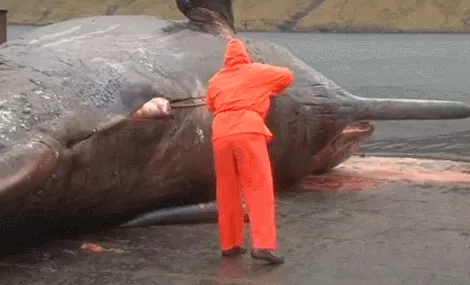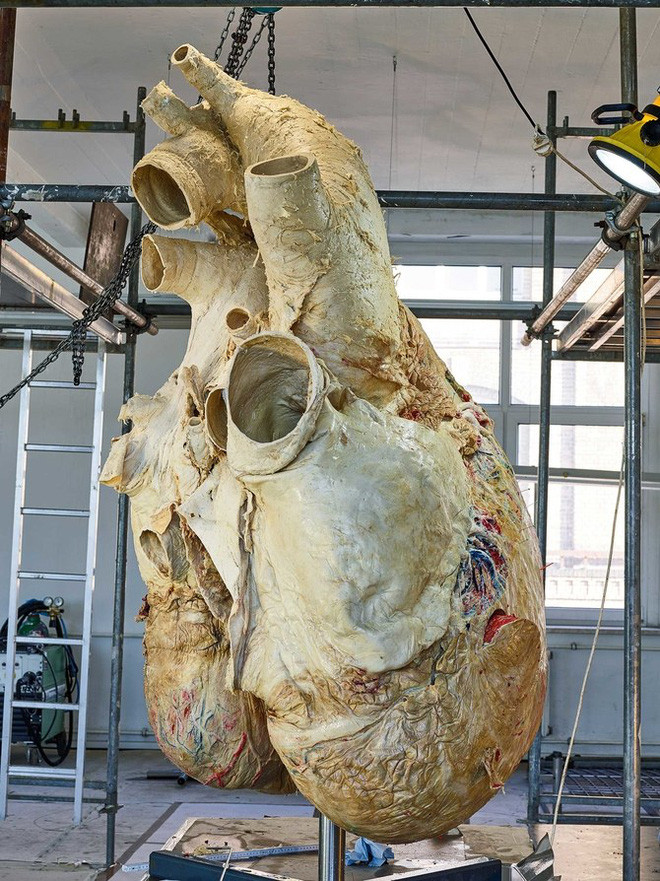The way scientists preserve whale hearts weighs 200 kilograms
Its body is so big that it needs a strong enough heart to survive, a heart weighing 200 kilograms!
When a whale dies, it becomes a giant mass of food floating on the sea surface, a source of nutrition for fish and seabirds. If the whale's body washed ashore, it was usually just a rotten fish that was in danger of exploding (due to the accumulation of gas in the body) at any time.

Whale corpses explode due to gas accumulation in the body.
But mammalian researchers at the Ontario Royal Museum in Toronto were lucky, when they met a corpse of a blue whale that drifted ashore still in good enough condition. That beautiful day in 2014, on the Newfoundland coast, they collected a whale heart weighing 200kg.

Whale heart.
'Because of its size, the rate of decomposition is accelerated, so we were very fortunate to have obtained its heart,' said Jaqueline Miller, who leads the heart preservation team. Recently, the heart has just been displayed to the public and on this occasion, Miller researcher talked more about the special preservation process called plastination - asking for permission to translate as 'plasticized' because too This process involves replacing water and fat in the specimen with some special resins.
And these are the stages:

Steps take the whale's heart out of the body and preserve it.
1. The process of taking the heart out of the animal's body
Ten workers use an iron hook to pull the whale's flesh, starting from the tail, to divide it into small pieces of meat. When they reached the heart, the technicians would cut the blood vessels leading to the heart, open the chest and push the heart out.
At this time, the team was standing in the knee of the whale's rotting flesh.'Like wrestling in mud' , Miller said.
2. Make the heart bloom
When no blood is transferred, the whale's heart will collapse. So the researchers put the tubes into two blood vessels, plugging the escape routes with plastic bottles and pouring into the heart more than 2,600 liters of formaldehyde. Their goal is to harden the heart muscle, stop the breakdown and inflate the heart to its original shape.
3. Shipping
They wrapped the heart in three absorbent layers, using a forklift to bring the heart into a large steel container and pour it into foam. Then, the heart is transported by air to Gubener Plastinate, a 'plasticized' facility in Germany.

The whale exploded during transport.
4. 'Plastinate - plastinate' stage
German surgeons will soak the heart in acetone (acetone) and replace it continuously. Over a 6-month period, acetone will replace water molecules in heart tissue. And then, the 'plasticisation' process will be carried out.
They will irrigate the heart of the silicon polymer solution and put the heart into a vacuum chamber. The air pressure will be reduced almost to the Universe, causing the acetone to fly away and polymer molecules replacing their place.
5. The process of 'belonging' to the heart
Engineers will use a gas to harden the silicon in the heart. After three months, the heart will become a giant plastic heart. After that, it could confidently stand in the museum without fear of the hands of the visiting people touching it.
- The biggest brain on the planet of sperm whale
- Search for the whale 'Forever Alone' most on Earth
- 10-ton whales drifted into Con Co island sea
- Discover shocking animal hearts
- 6 animals that possess the heart
- Rough whale weighs 2 tons and catches fishermen's nets
- Revealing secrets to help whales dive 'super good'
- Rare whales drift on American beaches
- Decode whale sounds
- Rescue 14m long whales stranded in Nghe An sea
- Listen to the songs that fascinate whale's hearts from the depths of the ocean
- Identify the 'strange' fish weighing 2 tons in Quang Tri
 Surprised: Fish that live in the dark ocean still see colors
Surprised: Fish that live in the dark ocean still see colors Japan suddenly caught the creature that caused the earthquake in the legend
Japan suddenly caught the creature that caused the earthquake in the legend A series of gray whale carcasses washed ashore on California's coast
A series of gray whale carcasses washed ashore on California's coast Compare the size of shark species in the world
Compare the size of shark species in the world Vietnamese doctor creates heart with parameters like human heart
Vietnamese doctor creates heart with parameters like human heart  How does chronic anxiety damage the heart?
How does chronic anxiety damage the heart?  Medical Mystery: Donated Heart Tells New Owner to Find Old Owner's Home, Even Though Identity Is Hidden
Medical Mystery: Donated Heart Tells New Owner to Find Old Owner's Home, Even Though Identity Is Hidden  Space Travel Weakens the Heart: Challenges for Astronauts on Space Exploration Missions!
Space Travel Weakens the Heart: Challenges for Astronauts on Space Exploration Missions!  'Decoding' the heart-shaped symbol
'Decoding' the heart-shaped symbol  Using 'virtual friends' to prevent and treat diseases
Using 'virtual friends' to prevent and treat diseases 